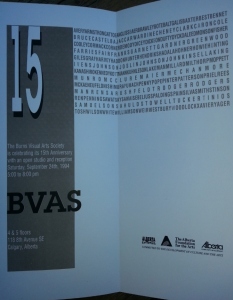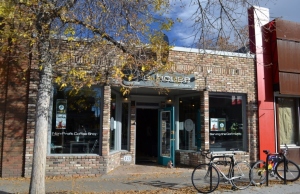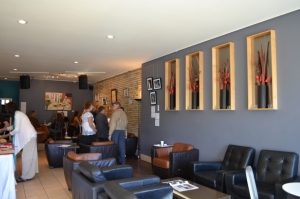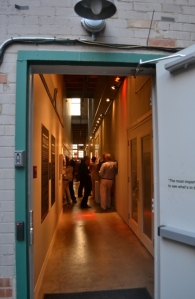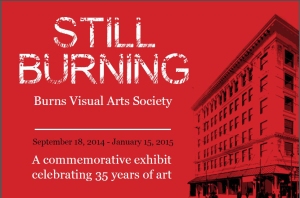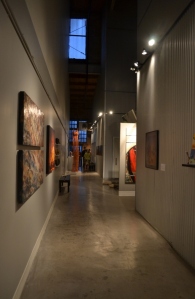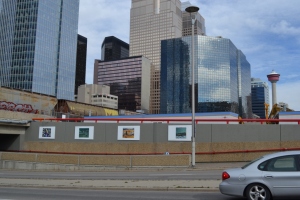
Recently I wrote about the Burns Visual Arts Society and their 35th anniversary.
As I was doing preparatory research for what I wrote, I encountered a news story that talked about the Neilson Building, and the space crisis for a number of arts organizations that were evicted to accommodate new buildings in 1996. One of those organizations mentioned was The New Gallery which returned back to its original home it had 20 years prior. The building they returned to was a small two-story commercial building facing 9th Avenue between 4th and 5th Streets, directly behind what was once Penny Lane Mall. If I was to guess it stood about where the East Lobby for the Eighth Avenue Place now is. Long story short, they stayed at that location for approximately 10 years. Most of those years I served as the treasurer for TNG. In turn as is often expected in Calgary for arts organizations, the building sold and they once again were evicted. It is all in the name of progress. It is the reality more often than not and just the way it is.
TNG has in turn occupied three different spaces, each time moving for the same reason significant renovations planned for each of the buildings they occupied – first it was Eau Claire Market (they had two different spaces there); then it was Art Central and now they are in Chinatown.
In addition Penny Lane Mall at various times housed commercial galleries, art exhibitions, pop-up galleries and artist studios over the years. In some ways it was a bit of a dead mall, but that was what sometimes made it possible for these organizations to survive. Underutilized commercial or retail spaces are an important part of the ecology for visual artists and arts organizations.
* * *
After my circuitous and rambling pre-amble . . .
The building that rose from the rubble of these two buildings (and others), is now known as Eighth Avenue Place.
There is a bit of an acknowledgement of the history of what once stood on the footprint of the current building location. It is a nice touch. Sadly so much of the knowledge of our city’s built history has been lost over the years. It is found on the +15 level near where SQ Commons once stood. It was in the midst of where the Art Forum Gallery Association‘s initial show which featured a retrospective exhibition of work by Alberta College of Art and Design instructor Dave Casey, the opening of which was held in October 2013.
It is a very interesting building with intriguing architecture. It is more unique than most in the city. I have intended to write about it for quite some time. I just have never got around to it.
A few days ago (Monday, September 22), I noticed that workmen with masonry drills and scissor lifts were installing large illustrated signs on the cement walls on the 5th Street SW underpass – a place where there has never been any signage or artwork previously (except for maybe the occasional piece of graffiti). This underpass is below the railway tracks between 9th and 10th Avenues. I continued on my merry way, but noticed artwork had been installed upon the large plywood or MDF panels, similar to what was done on the construction hoarding when the west tower of Eighth Avenue Place was being built last year.
At the time I thought the use of artwork on the construction hoarding to be a great way to promote Alberta artists and artworks.
I still do.
Of course this was rather fascinating for me to see, as only a month or two ago I wrote about the temporary chalk figures installed in conjunction with Beakerhead on the 4th Street underpass (on the other side of the block). They were there earlier this week, but have subsequently been painted over by Friday evening, September 26.
Recently, like within the year type of recent, the West Tower to the two tower Eighth Avenue Place was being built. The exterior construction of the second tower is now complete and the new portion of the complex is in the process of being populated with new office workers.
One of the interesting things that the building ownership group did when constructing the second tower was install construction hoarding around the site. That in itself is not all that interesting, but rather what they did with it was. As described in a small double-fold brochure produced by Hines Canada Management Co., ULC (I would assume was produced primarily for tenants) entitled Images of the Alberta Landscape: Sustainability, Art and Architecture, the area is described as follows:
Beginning on Eighth Avenue, following south on Fifth Street and then east along the busy downtown thoroughfare of Ninth Avenue, a continuous stream of art images engage the eye. Enlarged and reproduced on the construction hoarding at Eighth Avenue Place, this outdoor display of original works of Alberta art is a first for the city. A unique affirmation of Eighth Avenue Place’s commitment to Canadian art.
When this first went up probably about two years ago I was very excited to see some familiar works, some of which I had handled in a gallery sales situation previously. One of the works (a Helen Mackie print) I had even used for the print invitation to a solo exhibition of her work. It was truly a wonderful thing that the property owners (presumably) and/or property managers did to draw awareness to Alberta art. It is my wish that more situations would continue. The visual arts is a very challenging place to gain traction and positive awareness in this city. So any little piece of assistance, however small it may be, is greatly appreciated – not that I am working in that field anymore. This of course relates directly to my previous comment. In all there probably was somewhere in the range of 50-100 images used, with a template of the artists, titles and acknowledgement of collection (if applicable) found on each wall for reference.
The choice of selecting Alberta landscape based art was spot on, as it lent itself to the architecture of the building which features an irregular roofline on each of the two towers. This no doubt was meant to mirror the physical attributes of mountain peaks in an architectural manner. The external architecture and the external design of the construction hoarding worked well together.
I am uncertain exactly when this happened, but if memory serves me correct, the hoarding was removed at some point in the last couple months (maybe around Stampede?). I thought I had photos of the installation. After review, apparently I do not, nor could I find photos online. I would have been nice to have this for comparison purposes.
This rambling conversation leads me to the current installation on the 5th Street SW underpass.
As I looked at the works, I noticed a strong resemblance to those that I recall seeing on the Eighth Avenue Place construction hoarding last winter. In fact as seen in the photo below, four of the sixteen works are illustrated in the small brochure I have in my possession – Annora Brown, E.J. Hughes, Ron Moppett, and Walter J. Phillips.

This leads me to believe that those involved in putting up the construction hoarding at Eight Avenue Place, somehow must be involved in this as well. It would sense as it is practically across the street from where these images once stood.
My curiosity is, what is the connection?
There is a new development called Place Ten which is located between the 4th and 5th Street SW underpasses, facing 10th Avenue (as seen in the picture below with the base of Eighth Avenue Place the primary building complex directly behind the construction site. That would make this new construction site as being bounded by two sets of artwork- the Beakerhead art on one side and the Eighth Avenue Place art on the other.
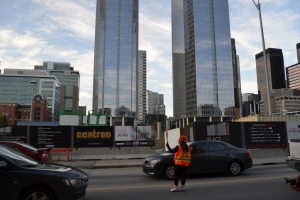
Is this the connection? Are both projects owned by the same ownership group?
The 16 artworks by 14 artists whose work is reproduced on the signage placed on the 5th Street SW underpass are:
- Barbara Ballachey [1945 – ] Butte Two, 1981 oil on canvas (Alberta Foundation for the Arts)
- Annora Brown [1899 – 1987] Foothills Village, n.d. oil on canvas (Glenbow Museum, Calgary)
- Michael Cameron [1955 – ] Searching for Elvis, 2012 oil on canvas (Elevation Gallery, Canmore)
- O.N. (Rick) de Grandmaison [1932 – 1985] Grey Road, 1983 oil on canvas board (Alberta Foundation for the Arts)
- Dulcie Foo Fat [1946 – ] Lake O’Hara Shoreline, 2006 (Alberta Foundation for the Arts)
- Roland Gissing [1895 – 1967] Clouds over the Prairie near Cardston, circa 1925 oil on canvas (Alberta Foundation for the Arts)
- Edward J. (E.J.) Hughes [1913 – 2007] Calgary, Alberta, 1955 watercolour on paper (Glenbow Museum, Calgary)
- Illingworth Kerr [1905 – 1989] Ranch Below Yellow Hills, 1971 oil on canvas board (Alberta Foundation for the Arts)
- Illingworth Kerr [1905 – 1989] Turner Valley Nocturne, 1986 oil on canvas (Art Gallery of Alberta, Edmonton)
- Illingworth Kerr [1905 – 1989] Young Antelope, n.d. linocut on paper (Edge Gallery, Canmore)
- Janet Mitchell [1912 – 1998] People of the Street #24, 1971 watercolour on paper (Alberta Foundation for the Arts)
- Ron Moppett [1945 – ] MoonWaterTree, 2010 alkyd, oil on linen and wood (TrepanierBaer Gallery)
- Walter J. Phillips [1884 – 1963] Mountain Torrent, 1926 colour woodblock on paper (Alberta Foundation for the Arts)
- John Snow [1911 – 2004] Near Bragg Creek, 1979 stone lithograph on paper (Collector’s Gallery, Calgary)
- Jack (J.B.) Taylor [1917 – 1970] Lake McArthur No. 7, 1963 oil on canvas (Alberta Foundation for the Arts)
- Doug Williamson [1974 –] Not by Our Wisdom, 2011 oil on linen (Edge Gallery, Canmore)
These type of selections always will involve a certain amount of second guessing. It is the nature of a curatorial project such as this, and is as predictable as death and taxes. The questions almost always are: 1.) why did they include these artists, and 2.) who did they miss?
As a result, I will try to keep my comments in this regard to a minimum.
- Of course the most obvious question is why was Illingworth Kerr selected three times and someone like Marion Nicoll whose work is included in the brochure photo I have included above, not included at all?
- The other interesting question is why was E.J. Hughes included? E.J. Hughes hardly can be called an Alberta artist. He had very little connection to Alberta outside of a short training period on one of the military bases, prior to being dispatched to serve overseas with the Princess Patricia’s (or the PPCLI) during WWII. Having said this, I am of the opinion that he is definitely an important artist worthy of inclusion in a Canadian landscape survey show.
An aside regarding the Hughes watercolour
I have often wondered and this is probably a rhetorical question more than anything else.
- Was this painting produced as a result of Hughes potentially being on holidays in Calgary during 1955?
- If so, did he attend the internationally travelling exhibition put together by Seagram’s entitled Views of Canada when it was on display at the old Calgary Allied Arts Centre (just down the street from where it is currently installed) in 1955?
- I wonder this, because A.C. Leighton (another Alberta artist who should be included) painted a very similar view of the Calgary skyline dated 1951 which is in the collection of the McCord Museum in Montreal. Recently many of the works were brought out of storage and re-circulated a few years ago. One of the stops in this most recent tour, was the Kamloops Art Gallery in which they illustrated the Leighton painting in this essay. As one can see from the two photos I have placed below for comparison purposes they are both taken from almost the exact same viewpoint on Rotary Park at the top of the Centre Street Bridge.
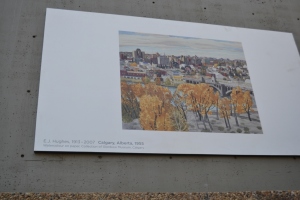
(The Hughes watercolour above)
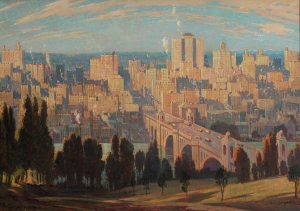
(the Leighton painting above)
Notwithstanding my comments about Hughes stated above, the work shows how others from elsewhere have interpreted the Alberta landscape.
Summary:
This situation was relatively common from the pre-Confederation era with early explorer/artists such as Paul Kane and William G.R. Hind (along with often forgotten anonymous aboriginal artists who produced petroglyphs and carved effigies found at places such as Writing-on-Stone Provincial Park and other traditional Native hunting grounds) until about the 1960s or 1970s when the provincial art scene could be considered to have begun its “coming of age” as evidenced by the Made in Calgary series of exhibitions hosted by the Glenbow – the final installment “the 2000s” which opened half the show last night at the Nickle Galleries at the University of Calgary and the main portion of the show which opens tomorrow at the Glenbow.
It could be argued that half the artists featured came from elsewhere (Foo Fat, Gissing, Hughes, Kerr, Moppett, Phillips and Taylor). This has not stopped their impact upon the art history of the province. This is evident from the place both Kerr and Phillips have, since both artists have public galleries named after them at the Alberta College of Art and Design (Kerr) or the Banff Centre (Phillips), recognizing their individual significant contributions to the province.
* * *
Addendum and Correction (2014 October 11)
In the body of this posting I indicated uncertainty about how these works ended up on the wall of the underpass. Quite by accident, when I was looking for something else, I stumbled upon something that helped solve this for me.
The mystery has been solved.
In a news release issued by the City on September 23, it was reported that this is part of the City of Calgary’s Underpass Enhancement Program which is a component of the Calgary Centre City Plan (2007). Elsewhere, it was disclosed that:
In early 2014, the Eighth Avenue Place Ownership Group offered the City of Calgary the gift of a number of graphic art panels that previously adorned the construction hoarding on their site.
In the news release from September 23, it is stated that this was done for the following reason(s):
The Centre City Underpass Enhancement Program is being implemented to achieve one of the objectives of the Centre City Plan: to make the Centre City a ‘walkable place that is safe, secure, accessible, legible, interesting and enjoyable for pedestrians’.
I believe that it does do this. It is also increases awareness and introduces an educational component regarding art from the region in a public setting. This is an important thing that is necessary to grow cultural awareness of the visual arts in the city.
For that I applaud this initiative.
